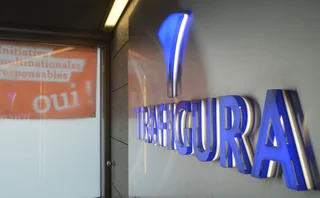
Dealers disagree over charge for CCP counterparty risk
Fed stress tests push US banks towards charging CVA for cleared derivatives

Amid the increasing use of central counterparties (CCPs) for over-the-counter derivatives, major dealers have adopted different approaches to adjusting the value of cleared trades to account for counterparty credit risk.
Several large dealers tell Risk.net they are taking a credit valuation adjustment (CVA) charge to reflect the counterparty risk of centrally cleared trades, or reporting the charge for regulatory purposes. However, the practice is far from universal, with US banks embracing the idea more readily than their European competitors.
“A CCP is a counterparty like any other counterparty,” says one risk manager at a large US bank. “It’s entirely logical that normal approaches to counterparty risk management should be used to address the risk they pose.”
But others disagree. In an illustration of the differences between banks, one London-based CVA trader says the counterparty risk of CCPs can’t be modelled or hedged, while the level of risk is minimal.
“There is probably a risk, but the risk is very much like a black swan,” he says. “First, the CCP is very unlikely to default, so the probability of default is very low. Second, it has got a very secure exposure, so the loss at default is reduced. Third, you can’t model it or hedge it, so there isn’t a lot of added value to monitor CVA on CCPs.”
With the inception of mandatory clearing under rules such as the European Market Infrastructure Regulation and the US Dodd-Frank Act, an increasing volume of OTC derivatives is being cleared via CCPs. By design, CCPs are meant to have very little counterparty risk: to cover potential losses, clearing members are required to post both initial margin and variation margin against their trades, and must also contribute to a sizeable default fund – typically one that is large enough to withstand the simultaneous default of its two largest members.
But CCPs are not risk-free, argue risk managers. Even if the CCP did not itself go bankrupt, dealers could stand to lose money if another large clearing member went bust and the resulting losses blew through the defaulting members’ initial margin and default fund contribution, as well as the CCP’s own capital.
A calculated risk
The issue of CVA for centrally cleared transactions raises challenges – not least, on the question of how to calculate the charge. “We are not using CVA for CCPs, but have discussed doing so,” says a risk manager at a large European bank. “However, given that there are no CVA spreads observable, we decided not to take a CVA charge.”
To judge the level of risk posed by a derivatives counterparty, banks would normally refer to the probability of default implied by credit default swap (CDS) spreads. But there is no liquid CDS market for CCPs.
Another option is to use credit ratings. In January, New York-based rating agency Moody’s Investors Service began assigning ratings to various clearing services using a methodology based on factors such as the products cleared, the CCP’s business model and the level of government support it might expect to receive.
However, some banks are critical of the agency’s methodology, and others say a more sophisticated approach is needed. “One of the simplest, naive approaches is just to say CVA for CCPs is no different than CVA for any other counterparty – so, you can use a rating-based credit curve to compute CVA,” said Youssef Elouerkhaoui, global head of credit quantitative analysis at Citi, addressing delegates at the Quant Summit Europe conference in London on April 13.
We calculate CVA on CCPs every day, not just for CCAR
A quant at a large US bank
A more rigorous way to compute CVA for CCPs, said Elouerkhaoui, would be to look at the CCP’s default waterfall in the same manner as a collateralised debt obligation (CDO). “CCPs and CDOs are very similar to some extent,” he said. “When a default happens on a CCP, we have a waterfall: the name goes bust, releases initial margin, releases guarantee fund, and so on, to pay for the losses on the default. So there is whole waterfall structure for the default payout of the CCP.”
In the US, large banks are required to report a CVA charge for trades with CCPs under CCAR – the annual stress test and capital planning exercise carried out by the US Federal Reserve Board. As part of CCAR, bank holding companies with consolidated assets of more than $50 billion must report CVA associated with CCPs on a quarterly basis as part of reporting form FR Y-14Q.
“[The Fed] came back to us two to three years ago saying, ‘We want you to start reporting CVA for CCPs as part of your base-case CVA reporting and also as part of your CCAR reporting,’” Elouerkhaoui told delegates at Quant Summit Europe.
Priced in
Although this is currently only a reporting requirement, some large US banks are going further and pricing CVA into all their centrally cleared trades. “We calculate CVA on CCPs every day, not just for CCAR. And these CVA calculations are always used to adjust the price of trades in official accounting measures,” says one quant at a second large US bank. “Numbers are obviously small.”
Elsewhere, JP Morgan’s credit portfolio group has been assessing and pricing CVA on cleared derivatives trades since 2011. The bank’s approach boils down to looking at the risk of clearing member portfolios as a proxy for the CCP itself. According to the bank’s analysis – shared with Risk.net at the time – the cost of protecting against losses on posted collateral, including initial margin and default fund contributions, would be comparable to buying super-senior credit protection. The bank declined to comment for this article.
While factoring CVA costs on cleared trades might be considered good practice from a risk management standpoint, it may have a palpable impact on the pricing of derivatives trades. That is potentially bad news for banks facing mounting costs from other regulatory initiatives, such as tougher capital and liquidity requirements laid down by the Basel Committee on Banking Supervision.
“The typical bid/ask spread on a cleared five-year interest rate swap is 2−3 basis points,” says one London-based consultant. “With that 2−3bp, banks should be able to cover their leverage ratio; their net stable funding ratio; everything else in terms of capital requirements on that trade, and give a 10% return on equity. [But] even without including these, banks are losing the market for interest rate swaps.”
Nevertheless, some argue that charging CVA on cleared derivatives is simply the right thing to do, regardless of competitive pressure.
“It’s irrelevant whether it is detrimental to the business; what matters is whether there is credit exposure or not,” says the quant at the second large US bank. “Assuming that CCPs have a non-zero probability of default and that the settlement process will not be instantaneous, then, yes, there is credit risk which should be priced.”
Only users who have a paid subscription or are part of a corporate subscription are able to print or copy content.
To access these options, along with all other subscription benefits, please contact info@risk.net or view our subscription options here: http://subscriptions.risk.net/subscribe
You are currently unable to print this content. Please contact info@risk.net to find out more.
You are currently unable to copy this content. Please contact info@risk.net to find out more.
Copyright Infopro Digital Limited. All rights reserved.
As outlined in our terms and conditions, https://www.infopro-digital.com/terms-and-conditions/subscriptions/ (point 2.4), printing is limited to a single copy.
If you would like to purchase additional rights please email info@risk.net
Copyright Infopro Digital Limited. All rights reserved.
You may share this content using our article tools. As outlined in our terms and conditions, https://www.infopro-digital.com/terms-and-conditions/subscriptions/ (clause 2.4), an Authorised User may only make one copy of the materials for their own personal use. You must also comply with the restrictions in clause 2.5.
If you would like to purchase additional rights please email info@risk.net
More on Risk management
BofA sets its sights on US synthetic risk transfer market
New trading initiative has already notched at least three transactions
Op risk data: At Trafigura, a $1 billion miss in Mongolia
Also: Insurance cartels, Santander settlement and TSB’s “woeful” customer treatment. Data by ORX News
Cyber risk can be modelled like credit risk, says Richmond Fed
US supervisors may begin to use historical datasets to assess risk at banks and system-wide
The changing shape of risk
S&P Global Market Intelligence’s head of credit and risk solutions reveals how firms are adjusting their strategies and capabilities to embrace a more holistic view of risk
To liquidity and beyond: new funding strategies for UK pensions and insurance
Prompted by policy shifts and macro events, pension funds and insurance firms are seeking alternative solutions around funding and liquidity
More cleared repo sponsors join Eurex ahead of cross-margining
End of TLTROs for banks and pension fund search for liquidity management tools drives uptake
Reimagining model risk management: new tools and approaches for a new era
A collaborative report by Chartis and Evalueserve on how the use of automation can combat the growing complexity of managing model risk due to regulation and market volatility
What Goldman’s appeal victory means for Fed stress tests
Decision could embolden more banks to appeal, analysts say. But others believe result is one-off







